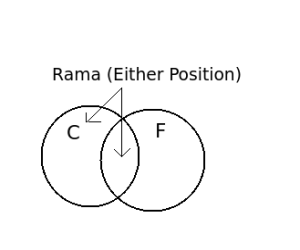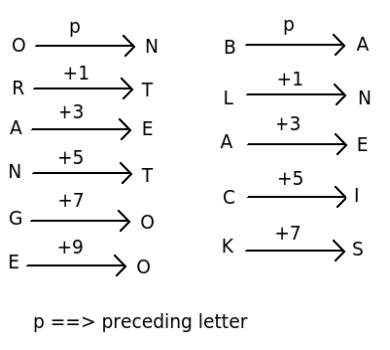1) Assume the given statements are true, even if they seem to be at variance from commonly known facts, then decide which of the given conclusion/s logically follows.
Statements :
I. Some cars can fly
II. Rama is a car.
Conclusion :
I. Rama can fly
II. Rama cannot fly
III. Rama can dance
IV. Rama can swim
a. Only I follows
b. Either I or II follows
c. Only III follows
d. All I, II, III and IV follow
e. All does not follow
|
Answer
Explanation
|
ANSWER: Either I or II follows
Explanation:
Statements:
I. some cars can fly
II. Rama is a car.

This diagram tells us that Rama may fall into any of the two groups – May be he can fly or he cannot.
Conclusion:
I. Rama can fly
II. Rama cannot fly
III. Rama can dance ------------ Does not follow
IV. Rama can swim ------------- Does not follow
|
|
2) In a code language “He gives flower” is written as “nop lui na” , “Bunty gets flower” is written as “dus lap na” and “He gets nothing” is written as “nop lap ugli”. How would “Bunty gets nothing” be written in that code ?
a. dus lap nop
b. na lap ugli
c. lui lap ugli
d. dus lap ugli
e. nop bas dus
|
Answer
Explanation
|
ANSWER: dus lap ugli
Explanation:
He gives flower ---------> nop lui na ---------- (a)
Bunty gets flower -------> dus lap na ----------- (b)
He gets nothing ----------> nop lap ugli --------- (c)
From a and b, we get “flower ===> na”; while from b and c, we get “gets ===> lap”. Hence from b, we get “Bunty ===> dus”. Now from a and c, we get “He ===> nop”.
Hence from c, we get “nothing ===> ugli”. Hence we have “Bunty gets nothing ===> dus lap ugli”.
|
|
3) A trader has 200 kg of sugar, out of which he sells some with 10% profit and the rest with 25% profit. He gains 15% on the whole. Find the quantity of sugar sold at 25% profit?
a. 120 kg
b. 96.5 kg
c. 84 kg
d. 67 kg
e. None of these
|
Answer
Explanation
|
ANSWER: 67 kg
Explanation:
Let CP of each kg. of sugar = Rs.1.
Cost Price of 200 kg of sugar = Rs.200.
Let quantity of sugar sold with 25% profit be X.
Therefore, (200 – X) kg of sugar sold at a profit of 10%
Then,
(125/100 * X) + 110/100 (200 – X) = 115/100 * 200
125X + 110(200 – X) = 115 * 200
125X + 22000 – 110X = 23000
125X – 110X = 23000 – 22000
15X = 1000
X = 1000/15
X = 66.66 kg
Quantity of sugar that was sold at 25% gain is 66.66 kg
Therefore, option nearby for 66.66 is 67 (d)
|
|
4) The incomes and expenditures of P, Q, R are in the ratio of 6 : 8 : 11 and 5 : 8 : 12 respectively. If P saves 1/4th of his income, what is the ratio of the savings of P, Q and R ?
a. 15 : 8 : 2
b. 19 : 7 : 9
c. 7 : 15 : 10
d. 12 : 9 : 17
e. None of these
|
Answer
Explanation
|
ANSWER: 15 : 8 : 2
Explanation:
Let the incomes of P, Q, R be 6x, 8x, 11x and expenditure be 5y, 8y and 12y respectively.
Therefore, savings are : (6x – 5y), (8x – 8y) and (11x – 12y)
Now, 6x – 5y = 1/4(6x)
24x – 20y = 6x
18x = 20y
x/y = 20/18 = 10 / 9
Savings of P / Savings of Q = 6x – 5y / 8x – 8y
= [6(x/y) – 5] / [8(x/y) – 8]
= [(6 * 10/9) – 5] / [(8 * 10/9) – 8]
= 15/8
Savings of Q / Savings of R = 8x – 8y / 11x – 12y
= [8(x/y) – 8] / [11(x/y) – 12]
= (8 * 10/9) – 8 / (11* 10/9) – 12
= 8/2
Ratio of savings of P : Q : R = 15 : 8 : 2
|
|
5) Ramesh spends 40% of his monthly salary on food, 40% of the remaining on conveyance and clothes and saves 50% of the remaining amount. If his monthly salary is Rs.17,000, how much money does he save every month ?
a. Rs. 3,400
b. Rs. 3060
c. Rs. 2,540
d. Rs.1,880
e. None of these
|
Answer
Explanation
|
ANSWER: Rs. 3060
Explanation:
Ramesh's monthly income = Rs.17,000
He spends 40% on food.
The total money spent on food = 40/100 * 17000 = Rs. 6800
Now, his monthly remaining income = Rs.17000 – Rs.6800 = Rs. 10200
Out of Rs. 10200, he spends 40% on conveyance and clothes.
The total money spent on conveyance and clothes = 40/100 * 10200 = Rs. 4080
Now, his monthly remaining income = Rs.10200 – Rs.4080 = Rs. 6120
Out of Rs. 6120, he saves 50%.
Amount saved = 50/100 * 6120 = Rs. 3060
|
|
6) Neha's mother was four times her age 12 years ago. She will be twice as old as Neha 12 years from now. What is the present age of Neha's mother ?
a. 49 years
b. 57 years
c. 60 years
d. 65 years
e. None of these
|
Answer
Explanation
|
ANSWER: 60 years
Explanation:
Let Neha's present age be 'x' years.
Her age 12 years ago = (x – 12) years
Therefore, her mother's age 12 years ago = 4(x – 12)
Her mother's present age = 4x – 48 + 12 = 4x – 36
Neha's age after 12 years = x + 12
Her mother's age after 12 years = 4x – 36 + 12 = 4x – 24
4x – 24 = 2(x + 12)
4x – 2x = 24 + 24
x = 24
Therefore, Neha's present age = 24
Her mother's present age = 4x – 36 = 4(24) – 36 = 60 years
|
|
7) In a certain code language, “ORANGE” is written as “NTETOO”. How would “BLACK” be written in that language ?
a. ANEIS
b. ANEJT
c. AMEIS
d. ANFIS
e. AMEJS
|
Answer
Explanation
|
ANSWER: ANEIS
Explanation:
A B C D E F G H I J K L M N O P Q R S T U V W X Y Z

|
|
8) A water tank has two pipes to fill water in it. One of the pipes fills water at the rate of 100 litres per hour. The tank is filled by the other pipe in 6 hours and by both pipes together in 4.2 hours. What is the capacity of the tank in litres ?
a. 860 litre
b. 980 litre
c. 1120 litre
d. 1400 litre
e. None of these
|
Answer
Explanation
|
ANSWER: 1400 litre
Explanation:
Let the time taken by the 1st pipe to fill the tank be x hours.
When both the pipes are open, it is given that:
1/x + 1/6 = 1/(4.2) of tank is filled in 1 hour.
1/x + 1/6 = 5/21
21(6 + x) = 30 x
9x = 126
x = 14 hours
Therefore, capacity of the tank = 100 * 14 = 1400 litres.
|
|
9) Akhil borrowed a certain sum of money at the rate of 6%, 9% and 14% for a period of first two years, next three years and beyond the period of five years respectively. If at the end of nine years, he paid Rs. 8550 as interest, then find the sum of money he had borrowed.
a. Rs. 9,000
b. Rs.14,000
c. Rs.15,000
d. Rs.18,000
e. None of these
|
Answer
Explanation
|
ANSWER: Rs. 9,000
Explanation:
Let Rs.P be the money borrowed by Akhil.
I) R = 6%, T = 2 years
Simple Interest of 2 years = PRT/100
= P * 6 * 2/100 = 12P/100
II) R = 9%, T = 3 years
Simple Interest of 3 years = P * 9 * 3/100 = 27P/100
III) R = 14%, T = 4 years
Simple Interest of 3 years= P * 14 * 4/100 = 56P/100
Therefore, total Simple Interest of 9 years
= 12P/100 + 27P/100 + 56P/100
= 95P/100
The total interest paid after nine years = Rs.8550
95P/100 = 8550
Therefore, 95P = 855,000
P = 855,000/95 = Rs. 9,000
Amount of money borrowed by Akhil = Rs. 9,000
|
|
10) In a library, there are certain number of books on a shelf, ranging between 75 and 100. 1/6th of them are fiction and 12.5% of them are non-fiction. Find the number of books.
a. 68
b. 72
c. 96
d. Can't be determined
e. None of these
|
Answer
Explanation
|
ANSWER: 96
Explanation:
12.5% can be written as 1/8th
Since 1/6th of the books are fiction and 1/8th are non-fiction, the total number of books must be exactly divisible by 6 and 8 and should be between 75 and 100.
Therefore, 96 is the only number, which fulfills the above criteria.
Note that the question doesn't imply that there are ONLY two varieties of books.
|
|
11) The average age of 19 boys and the class teacher is 16 years. If the ages of the class teacher and one of the boys are excluded, the average age reduces to 15 years. What is the age of the class teacher ?
a. 40 years
b. 36 years
c. 31 years
d. Data Inadequate
|
Answer
Explanation
|
ANSWER: Data Inadequate
Explanation:
No. of Persons = 19 boys + 1 class teacher = 20
Average age of 20 people is 16 years.
Therefore, total age of 20 persons = 20 * 16 = 320 years ------ (A)
If the class teacher and one boy are excluded, then the average age is 15 years.
Therefore, total age of 18 boys = 18 * 15 = 270 years ------ (B)
Age of the class teacher and one boy = 320 – 270 = 50 years.
Data is inadequate as the relation between the ages of the boy and the teacher is not provided.
|
|
12) Which symbol would be exactly at the middle of the fifth symbol from the right and ninth symbol from the left end of the following sequence of symbols ?
& * ∧ % $ # @ + - ! ∼ μ Ω Δ ± ∈ ≈ ∫ → √ ∞ ∧ @ ↓ ≥ ∈ $ + @
a. ±
b. ∫
c. ≈
d. Ω
e. ∞
|
Answer
Explanation
|
ANSWER: ≈
Explanation:
& * ∧ % $ # @ + - ! ∼ μ Ω Δ ± ∈ ≈ ∫ → √ ∞ ∧ @ ↓ ≥ ∈ $ + @
The fifth symbol from the right end of the given sequence is “≥”, while the ninth symbol from the left end of the sequence is “-”.
The symbol at the middle of “≥” and “-” is “ ≈ ”.
|
|